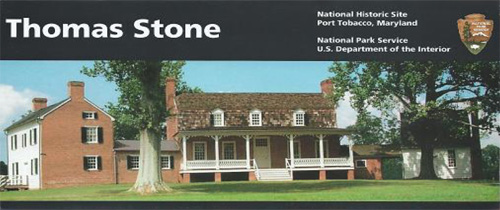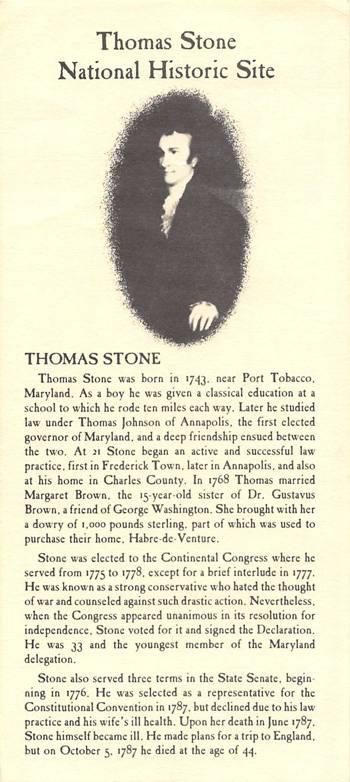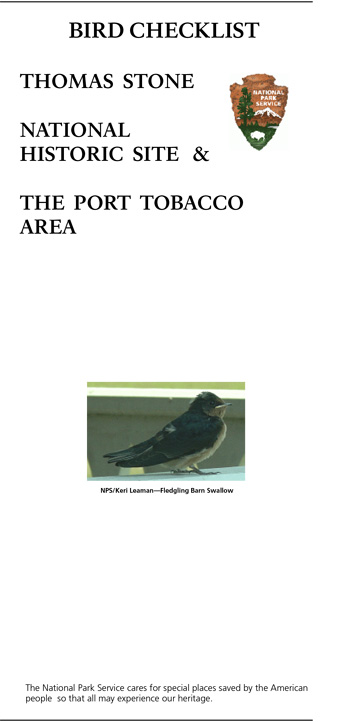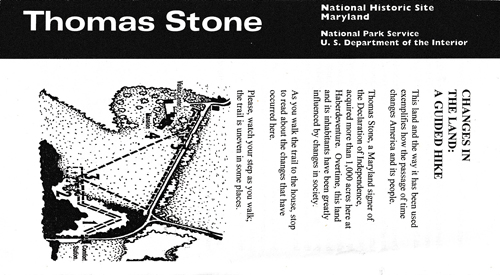|
Thomas Stone National Historic Site Maryland |
 |
 NPS photo | |
In Congress, July 4, 1776
Thomas Stone started building his home Haberdeventure in the 1770s as a place to raise his family. A modest family man then, Stone showed promise as a lawyer and local political figure. But soon Stone stepped onto a far larger stage. In 1776 Thomas Stone signed the Declaration of Independence—and wrote himself into history. Stone spent the rest of his life in public service. Haberdeventure, "dwelling place of the winds," stayed in the Stone family until the 1930s. Part of the National Park System, it commemorates this signer of the Declaration of Independence and honors his life.
Thomas Stone was born at Poynton Manor, near Port Tobacco, in Charles County, Maryland, in 1743. Little is known of his youth, but his education, as befit affluent young men of his day, emphasized Greek and Latin languages and philosophy. This early training later influenced his study of law. By 1765 Stone was practicing law as a circuit rider between Port Tobacco, Frederick, and Annapolis.
Stone was known to weigh all options in making decisions—a trait he carried into politics. At age 3l he was chosen as a member of the Charles County Committee of Correspondence, charged with keeping in touch with the other colonies, as tensions with Great Britain mounted. The next year the Maryland Convention chose him for the Second Continental Congress. When it met on May 10, 1775, the colonies were effectively at war. By 1776 Maryland stood for independence from Great Britain.
Had colonists not won the Revolutionary War, Thomas Stone could have been hunted down and hanged as a traitor to the British crown. And Stone, deliberative by nature, did not take lightly his change of heart: from loyal subject to American revolutionary. Independence, much less nationhood, was a fragile hope in 1776. What Stone signed was "The unanimous Declaration of the thirteen united States of America." The u in united was not capitalized. Nationhood—a United States of America—still lay in the future. Believing in peace, Stone had nevertheless come to see the colonies' escalating conflict with the British as the issue of freedom. But there was no script to follow. This was purely improvisation.
". . . we mutually pledge to each other our Lives, our Fortunes and our sacred Honor." As you look at Haberdeventure today, try to imagine Thomas Stone and his wife Margaret agonizing over putting everything they owned on the line—their home, the plantation, the slaves, and even Thomas's neck—against such a fragile hope of freedom for America.
. . . my heart wishes for peace . . . But war, anything is preferable to a surrender of our rights.
—Thomas Stone, April 24, 1776
18th-Century Plantation Life
Thomas Stone bought Haberdeventure as a country home more than for agricultural purposes. Cultivated since the 1680s, the depleted soil could not produce tobacco, the cash crop then. Stone grew grains and livestock and had gardens and orchards, mostly for the plantation residents, not for market. That was typical in the 1700s.
Livestock included chickens, cattle, oxen, sheep, and hogs. Flax and cotton were grown for making cloth. Old photos show apple, peach, cherry, pear; and plum trees, but we don't know when they were planted. (Outdoor photos were not common until the late 1800s.) Thomas Stone moved his wife and family to Annapolis in 1783, leaving a brother to manage the plantation. After Stone died in 1787 it passed down through five generations of Stones until it was sold in 1936.
Thomas Stone's writing desk symbolizes his role as a signer of the Declaration of Independence and one of the drafters of the Articles of Confederation, which governed the colonies from 1776 to 1789, when the Constitution was adopted. His work as a lawyer had prepared him to serve on the committees of correspondence that kept the colonies informed of political developments leading up to the revolution. Stone barely lived to see the new nation emerge, dying in 1787, age 44.
Visiting the Stone Plantation
Haberdeventure supported 25 to 35 people, including slaves and Thomas Stone's extended family. He enlarged the original 442-acre plantation to 1,077 acres. Wings are connected to the central block of the house by structures called hyphens, in an unusual arc resulting in a five-part colonial house. Fire destroyed the center block in 1977, and the home has been restored to its earliest known configuration, as seen in a 1902 photograph. The house was opened to the public in 1997.
The Past ls Still Present Here
 (click for larger map) |
The Stone family cemetery dates to 1787, final resting place of several generations of Haberdeventure residents, including Thomas and Margaret Stone. Outside its fence four stones mark the boundary of an extended cemetery, the final resting place of Stone family slaves. Watch for them as you explore the house and grounds. Several outbuildings, none from Thomas Stone's time, are witness to the continuing agricultural use of the property through five generations of Stone family ownership from 1770 to 1936.
About Your Visit
The site, at 6655 Rose Hill Road, four miles west of La Plata, Md., is open 9 a.m. to 5 p.m. daily in summer and Wednesday to Sunday from Labor Day to Memorial Day. It is closed Thanksgiving Day, December 25, and January 1. Admission is free. The visitor center offers information, exhibits, and a book store. It and the house are wheelchair-accessible. Park at the visitor center. (There is accessible parking at the house, too.) The cemetery is reached by a foot path across the field. Guided tours of the house are offered from 10 a.m. to 4 p.m.
Source: NPS Brochure (2012)
|
Establishment Thomas Stone National Historic Site — November 10, 1978 |
For More Information Please Visit The  OFFICIAL NPS WEBSITE |
Brochures ◆ Site Bulletins ◆ Trading Cards

Documents
Cultural Landscape Report: Thomas Stone National Historic Site (undated)
Cultural Landscapes Inventory: Thomas Stone NHS Landscape, Thomas Stone National Historic Site (2024)
Foundation Document, Thomas Stone National Historic Site, Maryland (June 2017)
Foundation Document Overview, Thomas Stone National Historic Site, Maryland (January 2017)
General Management Plan, Thomas Stone National Historic Site, Maryland (Spring 1989)
General Management Plan: Recommended Development Actions, Thomas Stone National Historic Site, Maryland (March 1990)
General Management Plan Revision and Environmental Assessment, Thomas Stone National Historic Site, Maryland (April 1996)
Geologic Resources Inventory Report, George Washington Birthplace National Monument and Thomas Stone National Historic Site NPS Natural Resource Report NPS/NRPC/GRD/NRR-2009/127 (T.L. Thornberry-Ehrlich, September 2009)
Historic Furnishings Report: Haberdeventure, Thomas Stone National Historic Site, Port Tobacco, Maryland (Carol Petravage, 1999)
Interpretive Prospectus: Thomas Stone National Historic Site (October 1990)
Inventory of Mammals (Excluding Bats) of Thomas Stone National Historic Site NPS Natural Resource Report NPS/NCBN/NRTR-2010/315 (Ronald R. Barry and Tressa L. Dolbeare, April 2010)
Junior Ranger Program (Ages 5-12), Thomas Stone National Historic Site (Date Unknown; for reference purposes only)
Long Range Interpretive Plan: Thomas Stone National Historic Site (March 2005)
National Register of Historic Places Nomination Form
Habre-de-Venture (Thomas Stone House) (Charles W. Snell, May 27, 1971)
Habre de Venture (Preston Parish, February 2, 1972)
Natural Resource Condition Assessments for George Washington Birthplace National Monument and Thomas Stone National Historic Site NPS Natural Resource Report NPS/NER/NRR-2012/576 (Stacy A. C. Nelson, Hugh A. Devine, Brett M. Hartis, Ernie F. Hain and William S. Slocumb, September 2012)
New Perspectives on Haberdeventure Plantation in Charles County, Maryland, 1770-1787: A Historic Resource Study of Thomas Stone National Historic Site, Port Tobacco, Maryland (Amy Speckart, February 2022)
Recent Climate Change Exposure of Thomas Stone National Historic Site (W.B. Monahan and N.A. Fisichelli, July 31, 2014)
Summary Report of Additional Research Finding: Thomas Stone National Historic Site, La Plata, Maryland (John Milner Architects, Inc., February 1993)
Vegetation Classification and Mapping at Thomas Stone National Historic Site, Maryland NPS Natural Resource Technical Report NPS/NER/NRTR—2012/550 (Chris Lea, Lesley A. Sneddon and Elizabeth Eastman, February 2012)
Thomas Stone State Historic Site in Charles County, MD
Books

thst/index.htm
Last Updated: 10-Oct-2024









